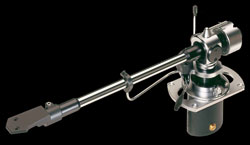

Torsional balance, which distributes the arm's weight equally between its two knife-edged vertical pivots, is accomplished by sliding a lateral rod (which holds the calibrated-scale weights) at the rear of the arm. We found this to be the most accurate calibrated force adjustment on any arm we have tested. With the static balance set, each calibration on the slider weight's scale represents a half-gram increment in tracking force. With the slide weight set at zero, the arm is adjusted for zero tracking force via a large ring weight at the rear of the arm. Stylus force is selected by a counterweight that slides along a calibrated rod.
How to set an sme tonearm plus#
Output wiring is five-circuit, providing isolated ground returns for both channels, plus a separate grounding circuit for the tonearm and turntable, for connection to the preamp chassis via a spade lug. The output cables are 48” long and terminated by labeled and color-coded phono plugs. An oval metal tube slides over the plug assembly to shield the entire junction. Interconnections between the fine tonearm cables and the heavy shielded output cables are made at a plug-in contact strip under the base of the arm.
How to set an sme tonearm free#
This way, the stylus will be free to slide across the template if the arm or turntable shifts slightly during the tangency adjustment. We suggest simply placing the stylus directly on the pinhole location on the template. We do not recommend punching the pinhole one slip of the hand, and the trapped stylus of a modern high-compliance pickup could be ruined. One of the templates suppliedthe tangency locatorhas a pinhole point that is supposed to accommodate the pick up's stylus tip. Templates and detailed instructions are supplied with the arm, and a precut mounting board (Model A39M) for the Thorens TD-121 or Thorens TD-124 turntable is available from Shure Bros, for $15. Tangency is adjusted by loosening a pair of knurled nuts beside the arm base, and sliding this along the bedplate. The screws hold a metal bed plate with an elongated cutout in it, and the arm base passes through this plate. Other features include a damped hydraulic lifter that lowers the arm gently onto the record when released (and then disengages itself), a wooden lining inside the arm tube, to reduce torsional and longitudinal resonances, and a flexible decoupling system for the counterweights, to provide "dynamic damping."įor mounting, the SME requires an elongated hole 1” wide by 2¾” long, ranged by four small holes for the mounting screws. The latter is adjustable over a wide enough range to accommodate a Euphonics Miniconic or an Ortofon pickup. It has wide-range adjustments for tangency, height, static balance, torsional balance, pickup tilt, bias compensation, and tracking force. The 3009 (with 9” pivot-to-stylus distance) is the arm we recommend for the home user, and it shares with the 3012 the distinction of being the most versatile conventional-type tonearm on the market today. The Model 3012 is 12” from pivot to stylus, to accommodate old broadcast-type 16” transcriptions, but its mass is too high for the majority of to day's high-compliance pickups. There are two models available, differing only in pivot-to-stylus distance and in total mass.

It was available in a stereo version as far back as 1961, and apart from a couple of minor refinementsthe addition of a bias compensator and a new, lightweight shellit is still the same arm, and it still has the reputation of being the perfectionist's tonearm.


 0 kommentar(er)
0 kommentar(er)
